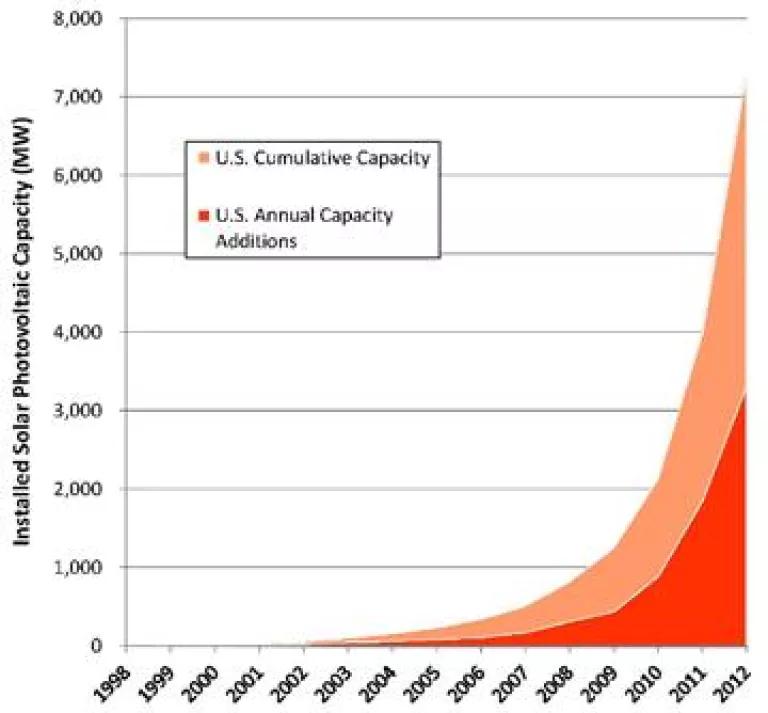Here’s an amazing fact: A collection of 12 states, with 28 percent of the US population, have a monumental 85% of the nation’s installed solar power.
That’s right: 85%.
These 12 states include some, like California, Arizona and Nevada, where the solar resource is some of the best in the world, not just the nation. But also listed in the new Environment America report Lighting the Way, about how state and local policies influence solar deployment, are some moderately lit East Coast states: New Jersey, Delaware, Massachusetts, Maryland.
For sure, the fast-plummeting cost of solar in the US is partially responsible for the incredibly rapid deployment of solar we’ve seen over the last five years. Today, the US has 10 times more solar than we did only five years ago, enough to power 1.3 million American homes. (Check out this very happy-making chart, below, for the full visual effect.)

Not only that, the US solar industry, which employed 93,500 in 2010, now has almost 120,000 on payroll, making solar one of our fastest-growing industries. (Here’s a particularly heartwarming story from West Virginia, where former coal miners are training as solar installers.)
These facts aren’t independent events. They’ve been spurred, in large part, by public policies and investments at the local, federal and state level. Of course, the 30% federal tax credit helps explain some of solar’s growth. By increasing demand for solar, it’s helped significantly lower the price. But the federal tax credit doesn’t explain why California has more than two gigawatts of solar photovoltaics installed, while almost equally sunny Texas, with two-thirds California’s population, has only 133 megawatts.
Instead, as Lighting the Way finds, state and local policies and incentives are driving much of the impressive solar progress in the 12 states Environment America calls the “Dazzling Dozen”: Arizona, California, Colorado, Delaware, Hawaii, Maryland, Massachusetts, Nevada, New Jersey, New Mexico, North Carolina and Vermont. These policies impact the nuts and bolts of solar deployment as well the big picture. Key to solar deployment, both Environment America and the National Renewable Energy Lab have found, are so-called state and local “market preparation” policies, as well as policies that help with “market creation” and “market expansion.”
Market creation has to do with basic policies that make solar feasible for those who want it. These policies include net metering, which allows owners of solar systems to sell the excess energy they generate back to the electric grid. Also important are interconnection rules, which clarify how utilities integrate solar power. Add to that: streamlined permitting policies; utility rate structures that charge more for electricity when demand is highest (think: hot summer afternoons); and, building codes that facilitate solar installation.
Also determined at the state level are market development policies that have been key drivers of solar deployment, such as state renewable energy standards that require states to get certain percentages of their energy from clean sources—wind, solar and energy efficiency, among them. Of the 29 states and the District of Columbia that have such standards, solar carve-outs, which require certain amounts of the standard be met with solar, are particularly effective. Finally, market expansion policies that offer financial incentives and creative financing options—allowing third-party ownership of solar systems, for instance, along with solar leases, on-bill financing through utilities, and Property Assessed Clean Energy (PACE) financing—helped speed deployment, too.
Just compare and contrast as Lighting the Way does:
• Eleven of the Dazzling Dozen states have strong net-metering policies. (Only North Carolina doesn’t. But its renewable energy standard makes up for it by incentivizing utility-scale solar installations.)
• Ten of the 12 have robust interconnection rules.
• Eleven of the 12 have renewable energy standards; nine have solar carve-outs.
• The vast majority allow for inventive financing options, such as third-party ownership.
The US solar resource—the amount of pollution-free energy we can get from the sun—is almost limitless. In more than half of our 50 states, rooftop solar power alone can supply at least 20 percent of our electric needs. In some particularly sunny states, that figure exceeds 30 percent.
In the 38 states that are not yet top performers, a large part of what’s preventing us from realizing solar’s many benefits is the absence of important state and local policies.
If I were those states, and wanted the jobs, clean air and global-warming pollution advantages that solar has to offer, I’d get moving now.




